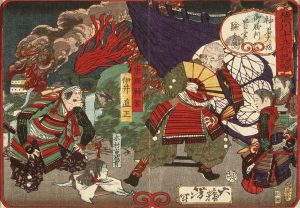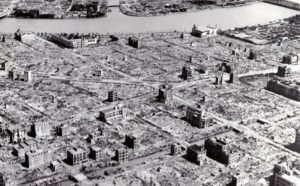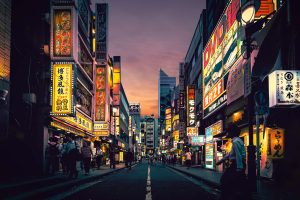Tokyo
12 History and Politics of Tokyo
Nicholas Powell
History

Tokyo’s meteoric rise to become the largest city in the world originally began in a small fishing village named Edo. The city grew after the Tokugawa Shogunate arrived in 1603 and established it as the de facto capital of Japan, launching the Edo period (1603 – 1867). Edo became the social and political center of the country while the de jure capital remained in Kyoto with the emperor. In 1868, the Emperor toppled the Shogunate in the Meiji Restoration and moved to Edo, officially renaming it Tokyo.
Following the Meiji restoration, The Meiji Period (1868 – 1912) was a time of great social and political change as the country began modernization and fell under the influence of other nations. Western powers forced Japan to sign one-sided treaties, advancing the desire to grow both militarily and economically. These radical reforms led to a financial crisis in the mid-1880s, which helped the establishment of the Bank of Japan and a large reform of their currency.
The population of Tokyo and other cities further increased during the Taisho period (1912 – 1926) as education improved and the country moved towards a consumerism lifestyle. Japan joined World War I on the side of the allies, hoping to improve relations between themselves and other western nations. Western powers rejected their proposals and legislation such as the Exclusion Act passed in the US Congress, prohibiting immigration from Japan despite their efforts. The economic situation in the country hit a low point after the Great Kanto Earthquake in 1923 destroyed much of Tokyo with its unrelenting shaking and fires. Over 140,000 people had been reported dead or missing and over 300,000 homes were destroyed in the aftermath. Massive spending increases followed the tragedy in the attempt to repair the city’s ruins.

The Showa period (1926 – 1989) began shortly after and, although it began strong, the greatest disasters had yet to come. The spending increases following the earthquake only worsened the economic collapse during the Great Depression. As its imperial ambitions grew, the country’s political situation allowed the military to take control of the government in the early 1930s. The Pacific theater of World War II broke out in 1941 with Japan joining the Axis powers opposite their World War I allies. With Tokyo being the capital of Japan, the war had a massive impact on the city. By the war’s end, the allies had bombed Tokyo 102 times. When the bombings of Hiroshima and Nagasaki finally proved that Japan could not win the war, Japan surrendered. By this time, the population of Tokyo had fallen to 3.49 million; nearly half of its 1940 population. In May 1947, the new Constitution of Japan took effect and Tokyo’s current 23-ward system fell into place.

In the 1960s, Japan experienced a period of rapid economic growth, leading to Tokyo’s current state today as the largest city in the world with a metropolitan area population of 37.5 million and a population within the city proper at 14 million. Modern Japan continued to expand and contract through the Heisei period (1989 – 2019) where, because of the success of the cities, the countryside has been rapidly shrinking as more and more people move for better opportunities.
As Japan enters the Reiwa period (2019 – present) Tokyo and the entire country face steep challenges. Its shrinking population and abandonment of the countryside will have to be addressed in the near future and although these challenges are tough, Japan and its capital have proven their resilience through the eras of history.
Politics
Japan is separated into several administrative districts called prefectures. Tokyo is both a city and a prefecture with the two being independent in the same way that New York City exists alongside New York state. The prefecture encompasses several smaller cities and towns while the Tokyo Metropolitan Government administers the city and its 23 special wards. These special wards also function similarly to independent cities themselves. Though other cities can establish special wards themselves, none have chosen to, making Tokyo unique among Japan’s cities.
Tokyo is the capital of Japan and the home of the Emperor who is the ceremonial head of state with no governmental powers. The government operates under the Constitution of Japan with legislative, executive, and judiciary branches similar in many ways to the structure of the United States. This similarity is unsurprising as the US had a large hand in shaping the Japanese constitution after its defeat in World War II.
Sources
TOKYO’S HISTORY, GEOGRAPHY, AND POPULATION
Media Attributions
- Tokugawa Ieyasu © Los Angeles County Museum of Art, Public domain, via Wikimedia Commons is licensed under a Public Domain license
- Tokyo WW2 © U.S. National Archives is licensed under a Public Domain license
- pexels-aleksandar-pasaric-2339009 © Aleksandar Pasaric

